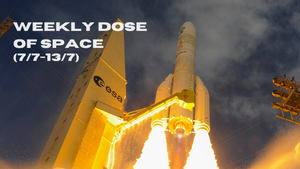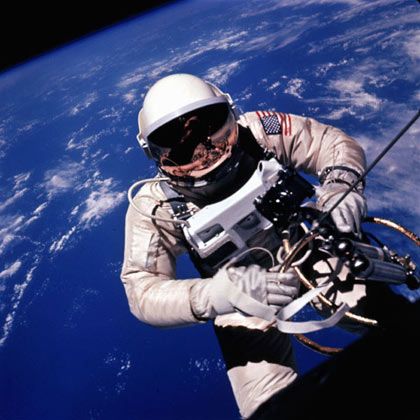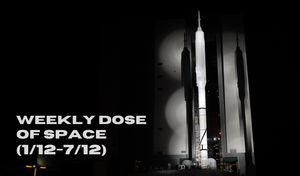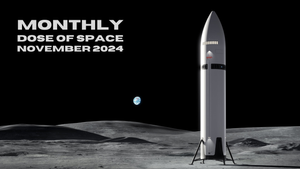
Weekly Dose of Space (7/7-13/7)
Welcome back to Weekly Dose of Space! Last week saw four orbital launch attempts occur, with only one completely succeeding. This week also had a test aircraft gain clearance to go supersonic and one of NASA's planetary exploration missions encounter a potential hardware problem. As always, we'll also look ahead to the worldwide launch schedule for next week.
SpaceX
This week at Starbase began on July 9th when Booster 12 was rolled out from the production site and headed for the launch site. Once at the launch site, Booster 12 was lifted onto the orbital launch mount ahead of testing.
Two days later, on July 11th, Booster 12 conducted a tanking test on the orbital launch mount, leaving frost on the outside for some time afterward. July 11th also saw the first module of the second launch tower be installed on the base of the tower, this module moved not long after we wrapped up last week's newsletter.
The next day Booster 12 was loaded with a small amount of both liquid methane and liquid oxygen for a spin prime test of its thirty-three engines. The 12th of July also had the second module for the second launch tower arrive at the launch site, with preparations for its installation underway on the 13th.
Launches This Week
July 9th - Falcon 9 with Türksat 6A
A Falcon 9 lifted off from Space Launch Complex 40, in Flordia, carrying Türksat 6A to a geostationary transfer orbit. The booster supporting this mission was B1076 on its fifteenth flight and landing downrange on the drone ship 'Just Read The Instructions'.

July 9th - Ariane 6 for its maiden flight
Ariane 6 flew on its maiden mission carrying seventeen payloads into low Earth orbit from Ensemble de Lancement Ariane 4 (Ariane Launch Complex 4), in French Guiana. Sadly one of the second-stages auxiliary propulsion units failed, causing the stage to remain stranded in orbit with two of its payloads. Details on the payloads and failure can be found here.

July 11th - Hyperbola-1 with three Yunyao-1 satellites
i-Space attempted to start its launches for 2024 with the launch of its seventh Hyperbola-1 from Launch Area 95A at the Jiuquan Satellite Launch Center, in northern China. However, Hyperbola-1 experienced an anomaly during its fourth-stage burn, leading to a loss of the vehicle and payloads.
Ah, the launch of the Hyperbola-1 carrier rocket this morning failed. The original plan was to send the satellite to the SSO, but there was an anomaly during the flight.😦 pic.twitter.com/OZgZbChoeS
— ᯅ̈?! (@dsshhh114) July 11, 2024
The launch of the Hyperbola-1 Y8 vehicle via dsshhh114 on X.
July 12th - Falcon 9 with Starlink Group 9-3
On July 12th, SpaceX launched what looked to be a typical Starlink mission atop of Falcon 9 from Space Launch Complex 4E in California, however the second-stage experienced an anomaly during its second burn. This anomaly would cause the twenty Starlink satellites to be released in a significantly lower orbit than planned, resulting in their eventual re-entry. The booster supporting this mission was B1063, on its nineteenth flight, which successfully landed on the drone ship 'Of Course I Still Love You' downrange. Details on the failure can be found here.
In Other Space News
Dawn Aerospace receives approval for supersonic flight

Dawn Aerospace announced on July 11th that New Zealand's Civil Aviation Authority had issued a certificate allowing the company to fly the Mk-II Aurora test aircraft above 80,000 feet, and up to "unlimited" speeds. The certificate also allows the aircraft to fly beyond visual line of sight outside of restricted airspace.
With the certificate from the Civil Aviation Authority, Dawn Aerospace will perform a series of test flights in the coming months working up to a speed of Mach 0.7. These tests will eventually allow the company to fly the Mk-II Aurora test aircraft at Mach 1.1.
Dawn Aerospace's ambitions for the Mk-II Aurora test aircraft include eventually flying missions up to 100 kilometers altitude for microgravity research, as well as proving technologies for its Mk-III Aurora air-launch platform for satellite launches.
Europa Clipper facing radiation vulnerability problems

NASA announced in a blog post on July 11th that transistors onboard its Europa Clipper spacecraft may not withstand the radiation environment around Jupiter. The Europa Clipper team was reportedly informed of this issue in May 2024 when similar parts used failed at lower radiation doses.
The manufacturer of the transistors and the Europer Clipper team are working together to understand the potential risks of using those parts on the spacecraft. NASA expected some of the transistors to fail if they are used near Jupiter, the agency is currently working to understand how many of the transistors will be susceptible to the issue and how long they would last in flight.
NASA is expecting preliminary analysis into the problem to be completed in late July, and is still expecting the mission to launch in October 2024.
JWST celebrates over two years of research

NASA, the European Space Agency, the Canadian Space Agency, and the Space Telescope Science Institute recently celebrated the second anniversary of the first images from the James Webb Space Telescope, which had its first images shared on July 11th 2022. To celebrate, the telescope team released images of the galaxies NGC 2936 and NGC 2937, which look like a penguin and an egg according to the teams.
The James Webb Space Telescope team explained the image of the two galaxies as follows: Two interacting galaxies, observed in near- and mid-infrared light. At left is NGC 2937, nicknamed the Egg. Its center is the brighter and whiter. There are six diffraction spikes atop its gauzy blue layers. At right is NGC 2936, nicknamed the Penguin. Its beak-like region points toward and above the Egg. Where the eye would be is a small, opaque yellow spiral. The Penguin’s distorted arms form the bird’s beak, back, and tail. The tail is wide and layered, like a beta fish’s tail. A semi-transparent blue hue traces the Penguin and extends from the galaxy, creating an upside-down U over top of both galaxies. At top right is another galaxy seen from the side, pointing roughly at a 45-degree angle. It is largely light blue. Its length appears approximately as long as the Egg’s height. One foreground star with large, bright blue diffraction spikes appears over top of the galaxy and another near it. The entire black background is filled with tiny, extremely distant galaxies.
Mark Clampin, Director of NASA's Astrophysics Division at its Headquarters in Washington, commented on the two-year anniversary saying:
“In just two years, Webb has transformed our view of the universe, enabling the kind of world-class science that drove NASA to make this mission a reality,” – “Webb is providing insights into longstanding mysteries about the early universe and ushering in a new era of studying distant worlds, while returning images that inspire people around the world and posing exciting new questions to answer. It has never been more possible to explore every facet of the universe.”
What to Expect Next Week
Starbase
SpaceX is still awaiting regulatory approval from the U.S. Federal Aviation Administration, as they are hoping to catch the Super Heavy booster during the fifth flight test. However, SpaceX is still believed to be targeting the launch of the fifth flight test of Starship-Super Heavy this month.
July 20th - Electron for 'A Sky Full of SARs'
Rocket Lab's Electron launch vehicle is expected to liftoff from Launch Complex 1B, located on the Māhia Peninsula in New Zealand. Electron is expected to carry a single Earth imaging synthetic aperture radar spacecraft to low Earth orbit for Capella Space.




